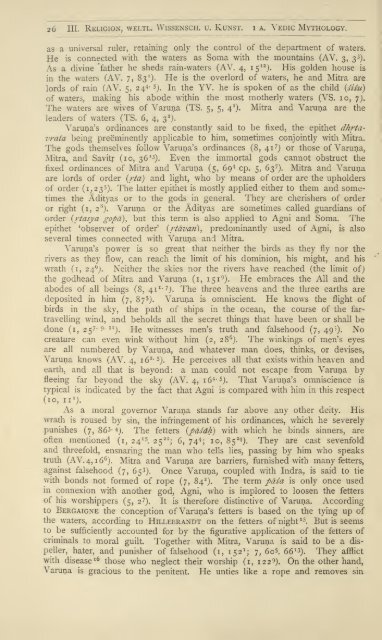You also want an ePaper? Increase the reach of your titles
YUMPU automatically turns print PDFs into web optimized ePapers that Google loves.
26 III. RELIGION, WELTL. WISSENSCH. u. KUNST. i A. YEDIC MYTHOLOGY.<br />
as a universal ruler, retaining only the control of the department of waters.<br />
He is connected with the waters as Soma with the mountains (AV. 3, 3 3<br />
).<br />
As a divine father he sheds rain-waters (AV. 4, i5 I2<br />
J. His golden house is<br />
in the waters (AV. 7, 83 ). He is the overlord of waters, he and Mitra are<br />
lords of rain (AV. 5, 24^- sj. jn the YV. he is spoken of as the child (sisu)<br />
of waters, making his abode within the most motherly waters (VS. 10, 7).<br />
The waters are wives of Varuna (TS. 5, 5, 4 1<br />
). Mitra and Varuna are the<br />
leaders of waters (TS. 6, 4, 3 2<br />
j.<br />
Varuna s ordinances are constantly said to be fixed, the epithet dhrtavrata<br />
being preeminently applicable to him, sometimes conjointly with Mitra.<br />
The gods themselves follow Varuna s ordinances (8, 4i 7<br />
) or those of Varuna,<br />
Mitra, and Savitr (10, 36 13 ). Even the immortal gods cannot obstruct the<br />
fixed ordinances of Mitra and Varuna (5, 69* cp. 5, 63"). Mitra and Varuna<br />
are lords of order (rta) and light, who by means of order are the upholders<br />
of order (1,235). The latter epithet is mostly applied either to them and some<br />
times the Adityas or to the gods in general. They are cherishers of order<br />
or right (i, 2 s<br />
). Varuna or the Adityas are sometimes called guardians of<br />
order (rtasya gopa], but this term is also applied to Agni and Soma. The<br />
epithet observer of order (rtdvari\, predominantly used of Agni, is also<br />
several times connected with Varuna and Mitra.<br />
Varuna s power is so great that neither the birds as they fly nor the<br />
rivers as they flow, can reach the limit of his dominion, his might, and his<br />
wrath (i, 24). Neither the skies nor the rivers have reached (the limit of)<br />
the godhead of Mitra and Varuna (i, i5i 9 ). He embraces the All and the<br />
I&lt;7<br />
abodes of all beings (8, 4i j. The three heavens<br />
deposited<br />
and the three earths are<br />
in him (7, 87 5 ). Varuna is omniscient. He knows the flight of<br />
birds in the sky, the path of ships in the ocean, the course of the fartravelling<br />
wind, and beholds all the secret things that have been or shall be<br />
done (i, 257-9- He witnesses men s truth and falsehood "j. (7, 49 ). No<br />
creature can even wink without him (2, 28 6 ). The winkings of men s eyes<br />
are all numbered by Varuna, and whatever man does, thinks, or devises,<br />
Varuna knows (AV. 4, i6 2 - 5 ). He perceives all that exists within heaven and<br />
earth, and all that is beyond: a man could not escape from Varuna by<br />
fleeing far beyond the sky (AV. 4, i6 4 5 ). That Varuna s omniscience is<br />
typical is indicated by the fact that Agni is compared with him in this respect<br />
(10,<br />
x<br />
ii j.<br />
As a moral governor Varuna stands far above any other deity. His<br />
wrath is roused by sin, the infringement of his ordinances, which he severely<br />
punishes (7,<br />
3&gt; 86 4<br />
). The fetters (pasah) with which he binds sinners, are<br />
often mentioned (i,<br />
15<br />
. 24<br />
25"; 6, 74 4 ; 10, 85 24 ). They<br />
are cast sevenfold<br />
and threefold, ensnaring the man who tells lies, passing by him who speaks<br />
truth (AV.4, i6 6<br />
j. Mitra and Varuna are barriers, furnished with many fetters,<br />
against falsehood 3<br />
(7, 65 ). Once Varuna, coupled with Indra, is said to tie<br />
2<br />
with bonds not formed of rope (7, 84 ). The term pdsa is only once used<br />
in connexion with another god, Agni, who is implored to loosen the fetters<br />
of his worshippers (5, 2 7 ). It is therefore distinctive of Varuna. According<br />
to BERGAIGNE the conception of Varuna s fetters is based on the tying up of<br />
the waters, according to HILLEBRANDT on the fetters of night 15 . But is seems<br />
to be sufficiently accounted for by the figurative application of the fetters of<br />
criminals to moral guilt. Together with Mitra, Varuna is said to be a dis-<br />
peller, hater, and punisher of falsehood (i, 152 ; 7, 60?. 66 13 ). They afflict<br />
with disease 16 those who neglect their worship (i, 1229). On the other hand,<br />
Varuna is gracious to the penitent. He unties like a rope and removes sin

















